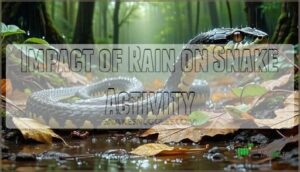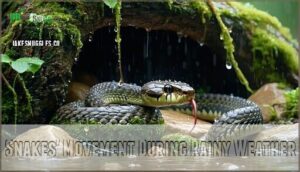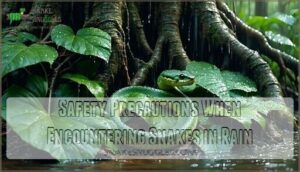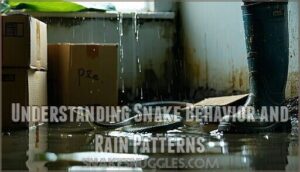This site is supported by our readers. We may earn a commission, at no cost to you, if you purchase through links.

Rain actually brings snakes out of hiding because it creates perfect hunting conditions. They’ll slither under rocks, logs, dense vegetation, or slip into burrows and crevices to stay dry while remaining close to active prey.
Think of it as their version of hunting from a cozy blind. The moisture drives out frogs, worms, and small mammals, making dinner easy to catch.
Rain doesn’t send snakes packing – it puts them on high alert, ready to strike when opportunity knocks, and this behavior is a result of the rain creating an environment that is ideal for hunting.
Table Of Contents
- Key Takeaways
- Where Do Snakes Go When It Rains?
- Snake Behavior in Rain
- Sheltering Behavior
- Impact of Rain on Snake Activity
- Snakes’ Movement During Rainy Weather
- Safety Precautions When Encountering Snakes in Rain
- Effects of Heavy Rain on Snake Habitats
- Snakes and Their Response to Rainfall
- Understanding Snake Behavior and Rain Patterns
- Frequently Asked Questions (FAQs)
- What do snakes do when it rains?
- Where do snakes go when it rains?
- Where do snakes hide in the rain?
- Where do snakes go during a storm?
- Will Rain bring snakes out?
- Are snakes more likely to see snakes when it rains?
- What do snakes do when its raining?
- Where do snakes go during storms?
- Does rain wash away snakes away?
- Are there more snakes when it rains?
- Conclusion
Key Takeaways
- You’ll find snakes don’t actually hide from rain—they become more active hunters as moisture drives out frogs, worms, and small mammals, creating perfect hunting conditions.
- When it rains, you’ll spot snakes seeking shelter under rocks, logs, dense vegetation, or in burrows while staying close to active prey, essentially hunting from cozy hideouts.
- You’re 50% more likely to encounter snakes during rainy weather since flooding forces them from underground dens to relocate to higher ground, including human structures like sheds and garages.
- You should maintain 6-10 feet distance from any snake during rain, wear protective clothing like thick boots and long pants, and avoid tall grass where displaced snakes might be hiding.
Where Do Snakes Go When It Rains?
When Mother Nature opens her floodgates, snakes in rain become master hide-and-seek champions.
These clever reptiles practice flood avoidance by seeking snake rain shelter in underground dens, beneath logs, rocks, or inside your shed—basically anywhere dry and safe.
Smart serpents dodge downpours by slipping into cozy hideaways—from rocky crevices to your backyard shed.
Snake behavior rain patterns show they’re not just hiding; they’re strategically positioning themselves.
Heavy downpours force snakes avoiding rain from flooded burrows to higher ground, while urban shelters like garages become prime real estate.
Rain also triggers prey availability, making hunting irresistible despite the weather.
You’ll spot where snakes hide changes dramatically—from cozy underground homes to elevated perches.
This temperature regulation and rain hydration balance keeps them active yet protected, explaining why you might see more slithering neighbors during storms.
They may even seek out communal dens for warmth.
Snake Behavior in Rain
Rain brings out a whole different side of snake behavior rain patterns that might surprise you. When storm clouds roll in, these cold-blooded creatures don’t just sit around waiting it out. Instead, they spring into action like they’ve been given a caffeine shot.
You’ll notice snakes in rain become incredibly active hunters. The moisture draws out frogs, insects, and small mammals – basically an all-you-can-eat buffet. Their hunting behavior kicks into overdrive as they capitalize on this prey bonanza.
Rain transforms snakes into opportunistic predators, turning every downpour into nature’s dinner bell.
Rain also triggers mating rituals in many species. The humidity provides perfect conditions for temperature regulation and skin hydration, making snakes feel more energetic and flexible. Some studies suggest venom potency may even increase during these active periods.
Snakes often exhibit increased activity in spring, which is part of their seasonal behavior patterns. Don’t be shocked if you spot more snakes in rain crossing paths or roads. They’re not avoiding the weather – they’re embracing it as nature’s dinner bell rings loud and clear.
Sheltering Behavior
You’ve seen how rain changes snake behavior, but where exactly do these slithery creatures find refuge? Their sheltering behavior reveals fascinating survival strategies that’ll surprise you.
Snakes transform into master hide-and-seek players when storms hit. They slip into Underground Havens like burrows and tunnel networks, where soil insulation keeps them warm and dry. Debris Hiding becomes their go-to strategy – they’ll squeeze under logs, rocks, and fallen branches faster than you can say "shelter."
When flooding threatens their underground homes, snakes showcase impressive Climbing Shelters behavior, scaling trees and bushes to escape rising water. They’ll even claim Urban Refuges in your shed, garage, or basement – turning human structures into their personal storm bunkers. During these times, they may seek refuge in manmade structures for protection.
Higher Ground becomes prime real estate during heavy downpours:
- Rock crevices offering maximum protection
- Dense vegetation creating natural umbrellas
- Abandoned animal dens providing ready-made refuges
- Boulder outcroppings forming weatherproof hideouts
- Deep ground holes maintaining stable temperatures
This snake avoiding rain strategy guarantees their survival while keeping their snake habitat rain preferences intact.
Impact of Rain on Snake Activity
Contrary to popular belief, rainfall doesn’t make snakes lazy—it supercharges their activity levels.
As ectothermic animals, snakes can’t regulate their own body temperature, so rain initially cools them down.
However, this weather shift triggers fascinating behavioral changes that might surprise you.
Temperature regulation becomes essential as snakes seek warmer microclimates during cooler, wet conditions.
The hunting behavior intensifies because rain drives their prey—frogs, insects, and small mammals—out of hiding spots, creating a buffet opportunity.
You’ll notice increased snake activity as they capitalize on this abundant food source.
Mating rituals also peak during rainy seasons since humid conditions favor reproduction.
This heightened activity boosts venom potency in venomous species due to increased metabolic demands.
Post-rain activity remains elevated as snakes continue exploiting favorable conditions.
Flooded burrows force snakes to relocate, often bringing them closer to human dwellings.
Understanding snake behavior in rain helps you recognize why encounters increase during wet weather, making awareness essential for safety.
Snakes also rely on hydration through food to maintain their health.
Snakes’ Movement During Rainy Weather
Snakes transform into strategic travelers when rain arrives, making calculated moves that might surprise you.
Their snake behavior shifts dramatically during rainy weather, creating fascinating snake movement patterns you’ll want to understand.
Here’s how snakes navigate wet conditions:
- Flooding Relocation: When burrows flood, snakes quickly relocate to higher ground or human structures like sheds and garages for immediate sheltering behavior.
- Activity Surge: Rain triggers increased hunting patterns as prey emerges, prompting snakes to leave their usual snake shelters for feeding opportunities.
- Temperature Regulation: Cold rain forces snakes to seek warm, dry spots under logs or rocks to maintain ideal body temperature.
This strategic movement explains why you’re more likely to encounter snakes during and after rainfall.
They may also exhibit defensive snake postures if disturbed during these relocations.
Safety Precautions When Encountering Snakes in Rain
Several key safety precautions can protect you during snake encounters in rainy weather. Maintain safe distancing of 6-10 feet from any snake you spot – they’re more active and unpredictable when seeking shelter.
Protective clothing like thick boots and long pants creates essential barriers against potential strikes. Monitor children closely during outdoor rainy activities, as curiosity often overrides caution.
Stick to established trails and avoid tall grass where snakes might hide. Use flashlights for better snake awareness in low-light conditions.
One should also be aware of symptoms of snakebites in case of an emergency. Never attempt to handle or move snakes yourself – contact professional removal services instead.
Learn basic first aid techniques before venturing outdoors, and keep emergency contacts handy. Remember, snake rain safety means staying alert, wearing appropriate gear, and respecting these creatures’ space when they’re displaced by weather.
Effects of Heavy Rain on Snake Habitats
Heavy rain turns snake habitats upside down, forcing these reptiles to pack up and move.
When flooded dens become waterlogged swimming pools, snakes can’t stick around. Habitat flooding destroys their cozy underground homes, while prey relocation means their dinner disappears too.
You’ll find them seeking shelter availability wherever they can – under your deck, in garages, or crawling toward urban areas. Snakes often rely on desert snake adaptations to survive in harsh conditions.
- Underground dens flood: Snakes abandon waterlogged burrows and hibernation sites
- Temperature impact: Cold, wet conditions force snakes toward warm, dry human structures
- Prey scatters: Heavy rain disrupts food sources, pushing snakes into new hunting territories
- Urban encroachment: Displaced snakes move closer to neighborhoods seeking suitable shelter
Snakes and Their Response to Rainfall
When nature’s sprinkler turns on, snakes showcase remarkable evolutionary adaptations that’ll surprise you.
These cold-blooded creatures don’t just hide—they strategically relocate using enhanced scent detection and temperature regulation. Rain hydration becomes vital as they seek ideal thermal zones while venom potency actually increases during wet weather activity.
Snakes can even use their scale sensilla to detect subtle vibrations in the water.
| Response Type | Snake Behavior | Survival Benefit |
|---|---|---|
| Shelter Seeking | Retreat to dens, logs, rocks | Maintains body temperature |
| Hunting Activity | Increased prey pursuit | Enhanced food availability |
| Habitat Relocation | Move to higher ground | Avoids flooding dangers |
| Urban Movement | Enter human structures | Finds dry, warm spaces |
| Hydration Strategy | Absorb moisture through skin | Essential water intake |
Understanding snake rain habits helps you recognize their natural shelter preferences and hiding spots during wet weather survival situations.
Understanding Snake Behavior and Rain Patterns
Weather-driven migration patterns reveal how rainfall cues trigger fascinating behavioral shifts in these remarkable reptiles.
You’ll discover that snakes don’t just randomly disappear when storms hit—they follow predictable rain patterns based on survival instincts honed over millions of years.
Snake behavior during wet weather centers on thermoregulation and flood avoidance.
When temperatures drop, they’ll abandon their usual snake hiding spots for warmer refuges like your basement or garage.
Their hunting adaptations actually increase during light rain, as prey becomes more active and scent trails strengthen.
Habitat relocation happens quickly when flooding threatens their snake natural shelter.
You can predict where they’ll go by understanding their priorities: staying dry, maintaining body heat, and accessing food sources.
These snake rain habits explain why you’ll spot them in unexpected places during storms.
To communicate, snakes often rely on chemical signals and pheromones.
Frequently Asked Questions (FAQs)
What do snakes do when it rains?
When it rains, you’ll find snakes seeking dry shelter under logs, rocks, or in burrows.
They become more active hunting prey that emerges during wet weather, often relocating to higher ground.
Where do snakes go when it rains?
When storms hit, you’ll find snakes seeking shelter under logs, rocks, or in burrows.
They’ll also slip into sheds, garages, or basements to stay dry and warm while avoiding flooded areas.
Where do snakes hide in the rain?
You’ll find snakes seeking shelter under logs, rocks, dense vegetation, and in burrows during rainfall.
They also hide beneath decks, sheds, or debris piles to stay dry and avoid flooded underground dens.
Where do snakes go during a storm?
Like cautious travelers fleeing a hurricane, snakes seek refuge in dry hideouts during storms.
They’ll slither under rocks, logs, or into burrows, avoiding flooded areas while hunting for higher ground until conditions improve.
Will Rain bring snakes out?
Yes, rain definitely brings snakes out.
You’ll see increased snake activity as they hunt for prey, seek new shelter from flooded burrows, and take advantage of humid conditions that make them more flexible and agile.
Are snakes more likely to see snakes when it rains?
Snake encounters increase by 50% during rainy weather as flooding drives them from underground dens to seek dry shelter.
You’re more likely to spot them crossing paths, hiding under porches, or slithering through yards.
What do snakes do when its raining?
When it’s raining, you’ll find snakes seeking dry shelter under logs, rocks, or in burrows.
They also move to higher ground, hunt active prey, and sometimes enter human structures like sheds to stay warm and dry.
Where do snakes go during storms?
During storms, you’ll find snakes seeking shelter under rocks, logs, or in burrows.
They’ll also hide in human structures like sheds, garages, or basements to stay dry and warm until conditions improve.
Does rain wash away snakes away?
Rain doesn’t wash snakes away, but it’ll drive them from flooded burrows to seek higher, drier ground.
You’ll find them hiding under logs, rocks, or even your deck until the water recedes.
Are there more snakes when it rains?
Yes, you’ll encounter more snakes during rainy weather.
Flooding forces them from underground burrows to seek dry shelter, while increased humidity boosts their activity levels and hunting behavior, making sightings more likely due to the snakes being more active and visible as they search for dry shelter.
Conclusion
Contrary to popular belief that snakes flee during storms, understanding where do snakes go when it rains reveals they’re actually becoming more active hunters.
You’ll find them strategically positioned under logs, rocks, and dense vegetation, waiting for rain-driven prey to emerge.
This knowledge helps you stay alert during wet weather, as snakes aren’t hiding away—they’re hunting nearby. Remember, rainy conditions create prime snake encounters, so you’ll want to watch your step and check sheltered areas carefully, especially during prime snake encounters.
- http://www.tacomasnakes.com/snakerain.html
- https://www.reddit.com/r/NoStupidQuestions/comments/1cv6pai/where_do_snakes_go_when_it_rains
- https://www.critterriddertx.com/snakes-in-the-rain-why-snakes-come-to-your-home-during-storms
- https://www.critterguard.org/blogs/articles/5-essential-tips-to-protect-your-home-from-snakes-during-stormy-weather
- http://wildliferemovalusa.com/snakerain.html












